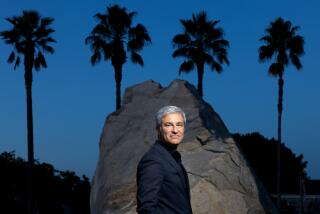Art collective ventures into community service
- Share via
“We were kind of kooky when we started, but no one treats us like were kooky anymore,” says Matias Viegener, co-founder of the L.A.-based art collective Fallen Fruit.
Conceived in 2004 with fellow Silver Lake artists David Burns and Austin Young, Fallen Fruit began as an art project to map fruit growing in public spaces. The message: One person’s overburdened branches and yard waste are another’s lunch. Over the last five years, public interest in the project has spiked as sustainable food sources and frugality have come increasingly into fashion.
“Now we seem really pragmatic,” Viegener says with a laugh. “It’s nice.”
The collective -- which isn’t a nonprofit but rather an ongoing art collaboration -- has since held events, including jam-making sessions at galleries, a South American residency to examine fruit farming, and a compelling and cheeky interactive banana exhibit at Los Angeles Contemporary Exhibitions last summer.
This year, the collective is tackling LACMA. After Fallen Fruit participated in Machine Project’s 2008 exhibit “A Field Guide to the Los Angeles County Museum of Art,” the group sprouted the idea for Eat LACMA, a nine-month series of events kicking off this weekend with tree adoptions, followed by lectures, tours, artist-curated gardens and food-themed art installations.
“All of our projects involve fruit, but Eat LACMA examines food in general,” Viegener says. “The art of the table, the centerpiece, even dinner music; food is a very primal form of culture because it connects us.”
“It’s central to everyone’s lives,” adds Michele Urton, LACMA’s assistant curator of contemporary art.
Eat LACMA will commence with two tree giveaways this weekend: One at Watts Towers on Saturday and another at LACMA on Sunday. Fallen Fruit will distribute 300 peach, nectarine, apple, tangerine and plum trees to anyone willing to plant them in public space or “on the perimeter.” That term, used often in Fallen Fruit discourse, refers to the edges of property lines, where branches overhang into public space and the excesses can easily and legally be shared by the community.
“If everyone planted a fruit tree in a public space, it would change the city,” says Fallen Fruit co-founder Burns. “It would change our relationship to the city; it would change our children’s relationship to it.”
This weekend, recipients can sign “adoption” papers pledging to care for their new tree and keep the collective updated. The progress of the tree is tracked, becoming a part of Fallen Fruit’s long-term art project.
Eat LACMA continues in March, when several artist-curated gardens will take root on the LACMA campus. Plans include a hanging garden of bitter melons, a Peruvian potato field and a fountain filled with live tilapia, which will be collected and cooked for a fish taco-meets-art function later in the year. Each garden is intended to create a “unique conversation,” Burns says.
On June 27, the collective will unveil “The Fruit of LACMA,” an exhibit representing food-related work culled from LACMA’s permanent collection. More than 50 pieces, including decorative art and classical paintings and even Harold E. Edgerton’s iconic “Shooting the Apple” photograph, examine the many complexities of human relationships with food.
Fallen Fruit will also debut a multimedia assemblage, for which it will solicit video of strangers dining, described by Burns as “60 seconds, head and shoulders, food in the face.” The user-submitted footage will become a montage of mouthfuls and screened on a loop. They’re hoping to collect submissions from different corners of the globe. Food is everywhere in art, but, Viegener notes, “We never see anyone eating.”
Eat LACMA will also include a jam-making session and a summertime event dubbed “ Salsa Salsa,” which delivers a one-two punch of tomato harvesting for pico de gallo, alongside spicy Latin dance instruction.
The series concludes in November with “Let Them Eat LACMA,” as food from the various gardens will be put to practical, edible use.
“For the final aspect, the public gets to eat the art,” says Fallen Fruit co-founder Young.
Fallen Fruit says the aspiration is to draw art lovers, environmentalists and curious foodies who otherwise may not commingle.
“What we’re excited about is not just the offshoot conversations about public space and sustainability and carbon footprints,” Burns says. “But it’s also the fact that one of the things we love to do is make jam with people we don’t know.”
Eat LACMA fruit tree giveaway Where: Saturday at Watts Towers Arts Center, 1727 E. 107th St., L.A.; Sunday at Los Angeles County Museum of Art, 5905 Wilshire Blvd., L.A. When: Noon each day. Price: Free Contact: (323) 857-6146; www.lacma.org










